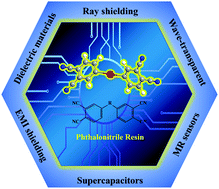An overview of high-performance phthalonitrile resins: fabrication and electronic applications
Abstract
As a newly developed thermosetting resin, phthalonitrile resin has shown potential applications in the electronics field recently due to its unique properties such as low dielectric loss, a densely cross-linked network and an abundant polyaromatic structure, high thermal stability and mechanical properties. In addition, the constructed polycondensed rings in the phthalonitrile resins after high temperature annealing enable them to serve as conductive materials. Thus, this review mainly focuses on the recent progress of the high-performance phthalonitrile resin for electronic applications. Firstly, the basic knowledge and manufacturing processes of phthalonitrile resins are summarized, followed by their advantages and challenges. Later, it provides the research progress of phthalonitrile resins in electronic applications including dielectrics, ray shielding materials, electromagnetic wave-transparent materials, electromagnetic interference (EMI) shielding materials, supercapacitors, and magnetoresistance (MR) materials. This knowledge will have great impacts on the field and facilitate researchers to seek new functions and applications of phthalonitrile resins for electronic devices in the future.



 Please wait while we load your content...
Please wait while we load your content...